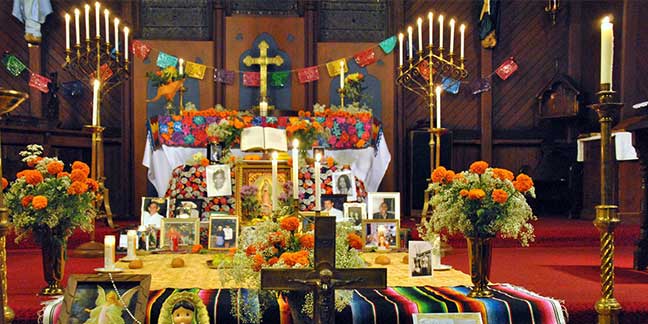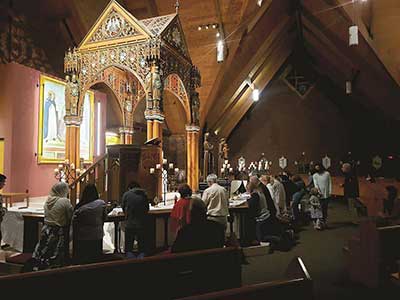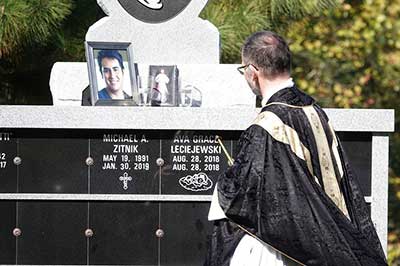Three days of prayers and celebrations for those gone before us
 As the liturgical year winds down and with Advent just weeks away, the Church celebrates the colorful season of “Hallowtide” – a three-day observance dedicated to remembering the dead, including saints, martyrs and all the faithful departed. The "triduum” of feast days begins Oct. 31 with All Hallows’ Eve (also called All Saints’ Eve, Day of the Dead among Hispanics and, of course, Halloween) and also includes All Saints Day Nov. 1 and All Souls’ Day Nov. 2. The feasts of Hallowtide date back to the 6th century. It is a festive, solemn and holy time the Church gives us to reflect on Christ’s triumph over sin and death, to meditate on our own mortality and relationship with God, and to honor the saints in heaven and pray for our deceased loved ones.
As the liturgical year winds down and with Advent just weeks away, the Church celebrates the colorful season of “Hallowtide” – a three-day observance dedicated to remembering the dead, including saints, martyrs and all the faithful departed. The "triduum” of feast days begins Oct. 31 with All Hallows’ Eve (also called All Saints’ Eve, Day of the Dead among Hispanics and, of course, Halloween) and also includes All Saints Day Nov. 1 and All Souls’ Day Nov. 2. The feasts of Hallowtide date back to the 6th century. It is a festive, solemn and holy time the Church gives us to reflect on Christ’s triumph over sin and death, to meditate on our own mortality and relationship with God, and to honor the saints in heaven and pray for our deceased loved ones.
All Hallows' Eve
All Hallows’ Eve falls on Oct. 31, the day before All Hallows’ Day (or All Saints Day), when the Church traditionally held a vigil as worshippers prepared themselves with prayers and fasting prior to the feast day itself. The name comes from the Old English “hallowed," meaning holy or sanctified – now shortened to the familiar word “Hallowe'en.” In the early Church, communities gathered to celebrate Mass and pray for the intercession of saints and for deceased loved ones. They built bonfires representing God’s light and victory over death and evil. The celebration has evolved to a more secular day of pumpkin carving, trick-or-treating, festive gatherings, costumes and treats.
Dia de los Muertos - Day of the Dead
The traditional Mexican holiday Dia de los Muertos – or Day of the Dead – has also become a mainstream holiday in American pop culture, with its colorfully decorated skulls and flowers adorning clothing featured in advertising and embraced by organizations from Hollywood to major league sports. But beyond its commercial appeal, the Day of the Dead has roots in Hispanic Catholic culture. The celebration coincides with the feasts of All Saints Day and All Souls’ Day. Despite its bleak name, Day of the Dead isn’t a time for mourning. It is a celebration of life – a time to honor the memory of deceased loved ones, to pray for the souls in purgatory, and to seek intercession on their behalf from those in heaven. The Day of the Dead is both festive and holy. Families visit the gravesites of their dearly departed, praying and beautifying the resting places with candles, flowers and personal memorabilia. They may read letters and tell anecdotes and jokes about their deceased loved ones. They also may bring a meal that includes the favorite foods of the deceased. It is tradition to go to Mass, and families create home altars with flowers and candles to remember and pray for the deceased.
 Create a home altar for Day of the Dead
Create a home altar for Day of the Dead
Home altars are usually comprised of triangular-shaped tiers representing three states of the Church: the living, the dead in purgatory, and the communion of saints in heaven. (Some refer to these as the “Church Militant,” the “Church Penitent,” and the “Church Triumphant.”) Follow these four steps to create your own Day of the Dead home altar:
1. Set up a three-tiered shelf or table in a prominent place in your home. On the top tier, prominently place a crucifix or icon of Our Lord, surrounded by images of saints or the Blessed Virgin Mary.
2. On the middle tier, place pictures or memorabilia of your deceased loved ones.
3. On the lowest tier, place favorite foods, candies or beverages of your deceased loved ones. Here, you can also place colorful skeletons or skulls made of sugar, clay or chocolate as a reminder that death is a certainty for us all, yet in this life, we strive for eternal life with God in heaven.
4. Use pieces of colorful paper, representing joy, to decorate and embellish your altar. Add flowers, such as yellow marigolds to symbolize Mary, to beautify the altar. Place votive candles on all three levels, symbolizing Christ as the Light of the World. Then, remember your departed loved ones at the altar – through prayer, by sharing funny and meaningful stories, and by serving their favorite foods.
Fun ways to celebrate Hallowtide
• Take your family to Mass on All Hallow’s Eve (Tuesday, Oct. 31), then enjoy a special feast and celebration with loved ones. (It’s also fine to indulge children in Halloween festivities.)
• When you go to Mass on All Saints Day (Wednesday, Nov. 1), honor and pray for the saints in heaven for all they have done for you. Pray especially to your patron saints.
• Read about the lives of the saints or have a party with games and costumes based on saints.
• On All Souls’ Day (Thursday, Nov. 2), pray for the souls in purgatory and make special sacrifices or give something up on their behalf, especially for deceased family members and others you have known and loved. Especially pray for those souls who have no one else to pray for them. You can even visit cemeteries to pray for the dead, lighting candles or bringing flowers. There is an indulgence for those who visit a cemetery and offer certain prayers on this day.
All Saints Day
 The Feast of All Saints dates to the 4th century when Christian communities held prayer vigils, lit fires and candles, and celebrated Masses for martyrs. These early celebrations were usually held around Pentecost (in May) or other holy days. In the 8th century, Pope Gregory III changed the date to Nov. 1 when he dedicated a chapel at the Vatican in honor of all the saints, and Pope Gregory IV later extended the celebration to the universal Church. One tradition associated with the feast day is going to Mass, and it is a holy day of obligation. Other traditions include reading and learning about the saints, saying special prayers to the saints, and asking for their intercession so that we too might become saints. Either on Oct. 31 or Nov. 1, it is also tradition for children to dress up in costumes of their favorite saints. On All Saints Day, we pray to the saints, known and unknown, that they continue to help and guide us along our path to salvation.
The Feast of All Saints dates to the 4th century when Christian communities held prayer vigils, lit fires and candles, and celebrated Masses for martyrs. These early celebrations were usually held around Pentecost (in May) or other holy days. In the 8th century, Pope Gregory III changed the date to Nov. 1 when he dedicated a chapel at the Vatican in honor of all the saints, and Pope Gregory IV later extended the celebration to the universal Church. One tradition associated with the feast day is going to Mass, and it is a holy day of obligation. Other traditions include reading and learning about the saints, saying special prayers to the saints, and asking for their intercession so that we too might become saints. Either on Oct. 31 or Nov. 1, it is also tradition for children to dress up in costumes of their favorite saints. On All Saints Day, we pray to the saints, known and unknown, that they continue to help and guide us along our path to salvation.
All Souls' Day
On Nov. 2, the Church commemorates all of the faithful departed. The Feast of All Souls is a holy day to honor and pray for the dead as they are being purified before entering heaven. Catholic teaching, rooted in scripture, says the soul of a person who dies goes to one of three places: heaven, where a person who dies in a state of grace and communion with God goes; hell, where those who die in a state of mortal sin are condemned by their choice; or purgatory, where sinners go to atone for their sins before going to heaven. Consistent with these teachings and traditions, Catholics believe that through the prayers of the faithful on earth, the souls in purgatory are cleansed of their sins so they may enter heaven. The custom of setting a special day to pray for the dead on Nov. 2 was first established by St. Odilo of Cluny in 998. While Nov. 2 remains the liturgical celebration date, the entire month of November has become associated in the Catholic tradition with praying for the departed. Parishes place lists of names of those to be remembered near the altar and pray for them at Masses throughout the month.

This prayer is traditionally said for departed loved ones to help get them to heaven. You can recite it when visiting someone’s grave, attending a funeral for a friend or loved one, or even after meals.
Prayer for the Faithful Departed
V. Eternal rest grant unto them, O Lord.
R. And let perpetual light shine upon them.
May the souls of all the faithful departed,
through the mercy of God,
rest in peace.
Amen.



 Create a home altar for Day of the Dead
Create a home altar for Day of the Dead